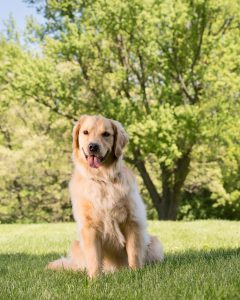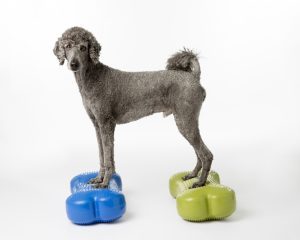The benefits of a therapeutic exercise program
If your dog has been diagnosed with arthritis, your veterinarian will likely tell you to make sure they get regular exercise.
Exercise, including walking, is a great way to help strengthen your dog’s muscles and manage pain and lameness. Other benefits include strengthening the bond between you and your dog and helping them lose weight!
But it needs to be done correctly!
In this article, we outline the 7 principles of a good therapeutic home exercise program as part of your dog’s arthritis management.
Principle #1: Building Blocks
Therapeutic exercises, which help build muscle strength and keep joints mobile, start with a foundation of basic obedience commands and “tricks.”
 Here are the ones your dog should know before you add more challenging exercises:
Here are the ones your dog should know before you add more challenging exercises:
- Sit
- Down
- Stand
- Stay/ Wait
- Here/ Touch (not the same as “come”)
- Shake (with both paws)
- Heel (walking on a leash without pulling)
If your dog does not already know these commands, we recommend that you teach them, working with a professional dog trainer if needed.
NOTE: Never use force when training! Dogs must be engaged in the activity because they want to. This will require using a reward to train with such as food, praise, or a toy.
Working on training
We recommend training using a clicker or capture word, such as “YES!” so you can reward your dog instantly when they perform the movement or command you asked. We also recommend “capturing” the following postures when your dog performs them naturally at home. Once they learn that these motions are “good,” they’ll become exercises your dog will want to do on command.
“Capture” positions/ commands:
- Play bow (downward dog; back legs straight with the rear end in the air while their front legs are stretched long in front of them—the CARE logo!)
- Upward dog (back legs are stretched out straight behind them while they stand straight on front legs)
- Backward walking/ backing up
Principle #2: Start Slow and Easy
Make sure you start all exercises at an easy level. This will ensure your dog has the proper form and doesn’t put too much stress on their body. It might seem boring or not challenging enough, but resist the urge to overdo it! If you ask them to do too much, especially when first starting out, you risk injuring your dog or at least making them very sore.
When starting a walking program, start with a distance you know your dog can manage without limping. You want to establish the baseline of what they can do without being sore (More on this in Principle 4). Then, you gradually build from there (See more in Principle 5).
This may mean that the first walk is very short. That’s OK! Walking for 1-2 minutes without limping is much better than walking for 10 minutes and having your dog limp home. That would set you back several days before you can establish the baseline again.
Principle #3: Correct Form Matters
Practice makes perfect! The more our bodies do specific activities, the more the motion becomes natural and automatic.
Muscles get trained to do a certain task or maintain a certain posture, and then the task becomes second nature. People with poor posture don’t think, “I want to slump my shoulders and hold my neck in a forward position.” (Did you just sit up straighter?) Having poor posture leads to further poor posture out of neuromuscular adaptation. In other words, it becomes a habit. And then the tissues adapt to the habit in either a good or bad way. This is the same for your dog!
When doing therapeutic exercises, you ONLY want your dog to do them with good form. Doing exercises with poor or wrong form will only reinforce the incorrect movements. This is why we start slowly with exercises your dog can already do, then we make it more challenging (Principle 5) once they have mastered an exercise with correct form.
Training good habits
The same is true even you’re starting a walking program after surgery. Your dog should only go for a walk if they’re using the leg that had surgery, rather than hopping on 3 legs. Otherwise, they learn that they can get where they want to go on 3 legs. This then starts a vicious cycle of muscle loss, joint and muscle stiffness, pain, and further limiting the use of their injured leg.
When performing repetitions of an exercise, make sure you always do the last repetition with proper form. This is why it’s important to watch for signs of fatigue (Principle 4) and stop before your dog’s form gets sloppy.
If you don’t catch it in time and your dog starts using a sloppy form, give them a break for 1-2 minutes. At the end of the break, ask them to perform only 1 repetition of the exercise, with a focus on good form.
Give lots of praise and reward your dog when the form is correct. Do not reward when the form is incorrect!
Be sure you know what good form looks like! Your rehabilitation therapist should have given you instruction on what good and bad form looks like for each exercise prescribed.
Principle #4: Watch for Fatigue—during and after exercise
If your dog could talk, you’d want them to tell you when they start feeling tired or weak during exercise. Since they can’t tell you with words, you must watch closely for signs of fatigue so you can stop the exercise before they develop a poor form (Principle 3).
Signs of fatigue include:
- Panting
- Lagging behind on a walk
- Limping
- Scuffing their toenails
- Muscle tremors
- Decreased interest in the reward
- Refusal to do the exercise
- Sitting down
- Laying down
- Incorrect form
Sometimes your dog just needs a rest and then they can do another set of exercise repetitions or walk a little bit further. Allow your dog to rest for 1-3 minutes, then ask them to do the exercise again. If they have proper form, you can ask for a few more repetitions. Other times, especially when starting an exercise program, only one set of exercises (or a short walk) should be performed and then your dog should be allowed to rest.
It’s a good idea to track how many repetitions you’re doing with each exercise, or how long you’re walking so that you can keep track of when they get tired.
Expect about 2 weeks before you start seeing improvement in fitness. Additional gains from there typically happen about every 4 weeks. Since exercise does not provide instant results in strength and endurance gains, tracking progress in a journal will help you see how far your dog has come. It will also help you stay motivated to keep working on your dog’s strength and mobility.
 Principle #5: Progression Matters
Principle #5: Progression Matters
The body adapts to the forces placed upon it (so long as the forces are not too high that they cause injury). We use this principle to increase strength, endurance, and flexibility. But, in order to make gains in fitness, you need to increase the amount of force (or load) gradually. If you want to run a marathon (26.2 miles), you train by gradually increasing the distance that you run so that your muscles, tendons, bones, heart, and lungs can adapt.
Therapeutic exercises are progressed by increasing one of the following variables:
- Time (How long you walk or how long a position, such as stretching, is held)
- Distance (How far you walk)
- Intensity (Making the exercise harder, either by making the surface uneven, walking faster, adding inclines/declines, or adding resistance)
- Repetitions
- This is the number of times the exercise is repeated in one “set.” A set includes a certain number of repetitions, or “reps.” Sets are separated by a break.
- For example, 2 sets of 5 reps would mean that your dog does 5 repetitions, takes a break (usually 1-3 minutes), then does another set of 5 reps
- Frequency (How often the exercise is done in a day or week)
Principle #6: Dogs get DOMS too
The feeling of sore muscles after you work out is not unique to humans. Delayed onset muscle soreness, or DOMS, can develop in dogs after they exercise, particularly if they are progressing through a rehabilitation program. DOMS typically sets in 1-2 days after exercise, then resolves by 3 days after exercise.
Why does DOMS occur?
When muscles are exercised, microscopic tears develop (this is a good thing, as opposed to a true muscle injury or strain). Once the muscle is resting, the body repairs these tiny injuries, and it is actually this process of repair that results in the muscle getting stronger. Muscles get stronger in order to adapt to the forces placed on them. Once a muscle has adapted to the new threshold, soreness is unlikely to occur. But in order to get even stronger, more force or load needs to be applied, and the process continues. DOMS is the soreness associated with the repair process in muscle adaptation to strength training.
The importance of starting slow, with easy exercises
In the early stages of rehabilitation, we do not want dogs to get DOMS, this is why exercise should start slow and easy.
If your dog seems sore or has an increased limping 1-2 days after exercise, it is likely DOMS. The worst things to do during this period are complete rest or heavier exercise. The best thing to do is an easy, gentle walk.
For example, if you have just progressed your dog to walking hills and added a new exercise and they seem sore the next day, go for a short, flat walk and skip any exercises for the next 2 days, or until the limp or soreness has resolved.
**If your dog develops a lameness that includes swelling, bruising, pain to the touch, is not using their leg at all, or continues to limp beyond the DOMS period, call your veterinarian as these could be signs of something more serious than DOMS and additional treatment may be needed.
Principle #7: Rest days are OK!
Your therapist will give you guidance on how frequently you should be performing your home exercise plan and walks. In some instances, daily walks and exercises are good/ ideal. Other times, especially when working on fitness and conditioning for sport, rest days are essential to allow the body to recover from training.

